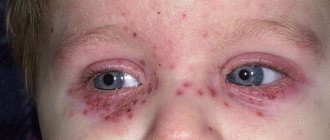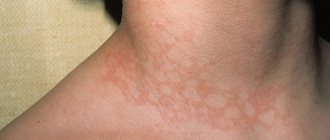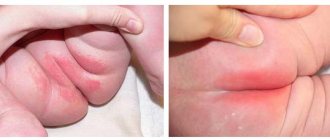Childhood illnesses with skin rashes
Many childhood diseases are accompanied by different types of rashes - blisters, pimples, acne, multi-colored spots, types of rashes can be seen in the photo. Skin manifestations are inherent in infectious and non-infectious pathologies.
Infectious diseases
Infectious diseases develop when pathogenic viruses, bacteria, fungi and parasites enter the body.
Types of viral rashes
Skin rashes are one of the main signs of infectious viral childhood pathologies; for each disease, the nature of the rash, its location and time of appearance are different, which greatly simplifies the diagnosis. Diseases are transmitted by airborne droplets, nutrition, and contact.
Diseases in which viral exanthems appear:
- Measles
is caused by an RNA virus. A papular rash, light spots on the bridge of the nose and behind the ears become noticeable 3-4 days after infection. Gradually, the rash spreads to the face, chest and upper back, skin of the arms and legs. Additional symptoms are cough, runny nose, conjunctivitis. - Rubella
is caused by togavirus. A rash in the form of small pale pink spots appears already on the first day of illness, first on the face, then moves to the sides of the torso, buttocks, arms and skin of the legs. Additional symptoms are joint pain, sleep disturbance, weakness, temperature rises to 39.5 degrees or more. The disease is most often diagnosed in children aged 6 months to 2–4 years. - Chickenpox
is caused by the herpes virus type 3.4, the disease is most often diagnosed in preschool children and primary schoolchildren. Vesicles cover the face, body, and sometimes mucous membranes, but there are no vesicles on the feet and palms. The first rashes appear on the face, scalp, groin and genital area, the child is bothered by severe itching, and in children the temperature rises briefly to 38–38.5 degrees. - Infantile roseola
is caused by herpes virus type 6.7. The child’s temperature rises sharply, but there are no other manifestations of disease; after 4–5 days the levels also drop sharply, and a rash appears on the body. - Warts and papillomas
are small pink or brown growths that can be flat or raised above the surface of the skin. Infection with papillomavirus occurs through close contact with a sick person, but pathology develops only when cellular immunity decreases. - Herpes simplex
is a viral infection in which blisters form on the mucous membrane and skin of the mouth, nose, and around the lips. - Infectious mononucleosis
is caused by Coxsackie enterovirus and Epstein-Barr virus. Generalized infection is accompanied by pain in the liver and spleen, swelling of the tonsils. Rashes in the form of red spots 5–15 mm in size appear on days 5–7 of illness, gradually merge, and are most often localized on the face. A special feature is that with mononucleosis the rash does not itch. - Erythema infectiosum
is caused by parvovirus. At the initial stage of development, the disease occurs like a cold; after a few days, numerous red pimples appear on the face and body. - Molluscum
is a viral infection; children most often become infected in swimming pools or when using hygiene items from a sick person. Initially, neoplasms appear under the skin; as the disease progresses, they come to the surface in the form of nodules; after opening, a white heterogeneous mass can be seen inside; it contains many viruses.
Important! Almost always, an infectious rash is accompanied by fever, weakness, and often enlarged lymph nodes. The rashes have a strict phasing pattern, gradually covering new areas of the skin.
Bacterial diseases
In children, bacterial diseases with skin manifestations most often occur against the background of infection with streptococci, staphylococci; microbes enter the body by airborne droplets, through wounds and scratches on the skin.
Types of pathologies:
- Scarlet fever is caused by streptococci from group A. The rash can appear within 24 hours after infection - extensive red roseola with small pink dots inside appear on the cheeks, rough to the touch, they gradually turn pale and turn brown. The rashes from the face spread to the stomach, back, neck, and thighs, but there is no rash in the area of the nasolabial triangle. Additional symptoms are fever, sore throat, diarrhea, the tongue is covered with a white coating, but after a day it turns red, and papillae are clearly visible on the surface.
- Erythema migrans is a bacterial dermatosis that occurs after a tick bite. After 1–2 days, a round spot appears at the site of the bite, the skin inside turns red, peels, and the inflammation gradually grows. Itching, tingling and irritation occur only if the bite occurs in an area with thin, sensitive skin. Without proper treatment, the infection spreads to the central nervous system and meningitis may develop.
- Folliculitis, furunculosis, carbunculosis - inflammation of one or more hair follicles, often the pathological process spreads to surrounding tissues. The affected areas are red and hot to the touch, and the disease is often accompanied by fever.
- Hidradenitis - ulcers form in the sweat glands, the rash is localized in the armpits, in the groin area, in the folds of the skin, the disease develops only in adolescents.
- Streptoderma - on the face and limbs, in the folds of the skin, bubbles with purulent contents appear, which easily burst, blisters and red ulcers form.
- Ecthyma - the skin becomes covered with deep ulcers with a diameter of 2–4 cm, the inflamed areas have a soft bottom and are covered with dry crusts.
Newborns are sometimes diagnosed with sexually transmitted diseases - syphilis, genital herpes, chlamydia; infection occurs in utero or as the child passes through the birth canal. Venereal rashes are varied - maculopapular rash, erosions, ulcers, chancre, nodules, they appear on the genitals, in the folds of the skin, on the face, and less often they can be found on the mucous membranes. STDs are often detected in adolescents who begin sexual activity early and have poor understanding of safe sex issues.
Staphylococci affect follicles and glands, streptococcal infections develop on smooth skin, most often around the mouth and nose.
Parasitic infections
Parasitic diseases occur when infected with lice and mites; the pathologies are very contagious and spread rapidly in children's groups.
List of common diseases:
- Pediculosis
is an infestation of lice. The disease is accompanied by severe itching, red dots appear on the skin, and there are many nits on the hair. - Scabies
is an infection with the scabies mite. Scabies are formed on the skin - small winding lines of pink or gray color; the disease is characterized by severe itching, which intensifies at night. - Demodicosis
is an infection with the demodex mite. The disease manifests itself in the form of rosacea and granulomas; sores on the face are accompanied by severe itching of the eyes and profuse lacrimation.
A rash on the body often occurs when infected with worms - parasites secrete toxic substances during their life activities, which causes severe allergic reactions
Fungal pathologies
Mycoses occur with the active growth of pathogenic fungi; they often affect not only the skin, but also the hair and nail plates; rashes usually affect large areas. The causes of diseases are long-term use of antibiotics or the use of antiseptics, disruptions in the endocrine system, poor ecology, vitamin deficiency, and frequent stress.
Types of mycoses in children:
- Keratomycosis
- pityriasis versicolor, pityriasis versicolor, nodular trichosporia. The diseases are characterized by the absence of an inflammatory process and minor damage to the upper layers of the epidermis. - Dermatophytosis
– trichophytosis, microsporia. Pathological processes penetrate deep into the epidermis and affect nails and hair. - Candidiasis
- occurs when the number of fungi of the genus Candida increases. The pathology affects the skin and mucous membranes, accompanied by the appearance of a cheesy coating with a sour odor and numerous small white pimples. - Deep mycoses
– chromomycosis, histoplasmosis, blastomycosis. Fungi penetrate deep into the skin, affecting nearby tissues and internal organs.
A fungal rash looks like spots of different diameters and shapes; they can be pink or yellowish-brown, their surface is flaky and covered with scales.
Fungal diseases are often chronic, with exacerbations occurring due to weakened immunity.
Non-infectious types of rash
Non-infectious rashes occur due to improper care and may indicate disturbances in the functioning of internal organs.
The main types of rashes of non-infectious origin:
- Neonatal acne – numerous yellow or white pimples on the forehead, cheeks, and around the nose are present at birth or appear during the first 6 months of a child’s life. The pathology occurs under the influence of the hormone estrogen, due to the active work of the sex glands, and does not require specific treatment.
- Erythema toxicum is a reaction of a newborn’s skin to a new environment. Groups of spots of different sizes appear on the chest, buttocks, and in the bends of the limbs, yellowish-gray blisters, and the skin in the areas of the rash is dense. In a localized form, the rash disappears within 2–4 days; in a generalized and widespread form, it can persist for up to 20 days, with an increase in temperature, and the baby becomes restless due to severe itching.
- Milia - small white nodules localized on the face. The disease develops 7–14 days after the birth of the child due to blockage of the sebaceous glands.
- Pilar (follicular) keratosis is a chronic disease that occurs due to a disruption in the process of desquamation and keratinization of epithelial cells. Small rough nodules appear in the locations of the hair follicles, most often the disease goes away with the onset of puberty.
- Diaper dermatitis is a consequence of improper skin care for a child. Redness, blisters, and peeling appear in the groin area, in the folds of the skin, and in places of friction with clothing.
- Seborrheic dermatitis - develops in newborns and adolescents when the sebaceous glands are disrupted; the problem arises due to overheating, excessive sweating, dietary errors, and stress. Symptoms: the skin swells, turns red, peels, there is severe itching and burning, the condition and appearance of the hair worsens, but yellow crusts appear on the head.
- Miliaria - skin irritation due to increased sweating, failure to comply with hygiene standards, small bubbles of pink, pearlescent, white, flesh color appear.
Swelling and itchy rashes after insect bites are a type of non-infectious rash.
Allergic skin diseases
Allergic dermatoses are quite often detected in children; they develop against the background of infectious pathologies, poor nutrition; allergens can be foods, household chemicals, pollen, animal hair, dust, and medications. Allergies are often inherited.
List of dermatoses of allergic origin:
- Contact dermatitis
- severe irritation occurs after contact with household chemicals, some plants, intolerance to sunlight, low temperatures. Usually blisters and red spots disappear on their own when exposure to allergens stops. - Diathesis
– red, rough spots appear on the cheeks; the disease occurs in infants under one year of age if the mother consumes prohibited foods; in older children, such rashes indicate a food allergy. - Atopic dermatitis
is the most common type of allergic childhood pathology and is often hereditary. A polymorphic rash in the form of red spots of irregular shape, pustules, vesicles appears in various areas, but most often on the face, head, in places where joints are bent, and in folds. Symptoms are severe itching, redness of the skin, vascular network, increased dryness of the skin, thickening of all layers of the epidermis, disturbance of the psycho-emotional state. - Toxidermia
is an acute inflammation of the skin and mucous membranes that manifests itself under the influence of allergens and is characterized by the appearance of rashes, blisters, and purulent nodules. Irritants can be food, medications, toxic fumes. Additional symptoms are fever, chills, itching, inflamed areas hurt, and sometimes vomiting and nausea are observed. - Urticaria
- occurs after contact with plants, insect bites, consumption of allergenic foods, during treatment with antibiotics, against the background of infectious diseases. The blisters are localized in different areas of the skin and mucous membranes, and the child is bothered by severe itching. - Eczema
is often a consequence of severe stress, the disease is recurrent in nature, and aggravation is noted in winter.
Often, a rash appears during ARVI or influenza - this is associated with a sharp decrease in immunity, which leads to the appearance of allergic rashes. With a cold, urticaria is most often observed - multiple small blisters form on the skin.
Rash as a manifestation of diseases of internal organs
Often, a rash indicates a disruption in the functioning of internal organs; rashes appear if a large number of toxins accumulate in the body, some of them are excreted through the pores. Most often, skin manifestations occur in diseases of the gastrointestinal tract, liver, intestines, and hematological pathologies.
Description of rashes in various diseases
| Types of diseases | Characteristics of rashes |
| Bowel diseases | Dermatitis, pimples, acne, peeling - usually the rashes are localized on the face. |
| Liver diseases | Single red spots, pustules, small pink rashes all over the body, the skin on the palms becomes marbled. Liver plaques are flat, yellowish lumps located on the limbs, eyelids, and armpits. |
| Blood diseases | Purpura - numerous small bruises throughout the body. Small nodules on the lower limbs and buttocks. |
| Kidney diseases | Increased dryness, yellowing of the skin, age spots, itchy rash all over the body. |
In diseases of the internal organs, the rash is usually located symmetrically.
What is Vitiligo?
As mentioned earlier, the most common disease that is accompanied by the appearance of white spots on the skin is Vitiligo. As a result of this disease, spots of various shapes and sizes appear on the skin of adults and children; the cause is the lack of melanin. As a result, the skin is not protected from sun exposure and there is a risk of getting a burn.
Manifestation of Vitiligo:
- On the arms and face, in the elbows and groin.
- Spots appear in separate areas or create groups that merge into a single spot that occupies most of the body.
- The disease does not appear on the feet and palms.
- If spots appear on the head, the hair also loses color.
Causes of the disease:
- Heredity.
- Impaired liver function.
- Diseases of the thyroid gland and endocrine system.
- Incorrect functioning of the pituitary gland.
- Gastrointestinal disease.
- Disease of the kidneys and adrenal glands.
- Stress and infectious diseases.
- Malfunctions of the immune system.
- Disturbed balance of vitamins and microelements.
Vitiligo is often confused with other diseases, namely:
- Leucoderma.
- Ringworm.
- Pityriasis versicolor.
Important! Only a dermatologist can determine the cause of spots and methods of treating them, so do not delay your visit to the doctor.
Rules of caution:
- You can't sunbathe with a sweaty body.
- It is forbidden to stay in drafts for a long time.
- It is not advisable to use air conditioners and fans.
- You should not stay in air with high humidity levels for a long time.
Important! In general, any violation of the skin is a health problem, however, Vitiligo is not an infectious disease, so it does not pose a danger to others.
Treatment of skin diseases in children
Since childhood skin diseases occur under the influence of various factors, if a rash appears in a child, visit a dermatologist, he will prescribe tests to identify the causes of the pathology.
To combat dermatosis, drugs are used against the main causative agents of the disease, external agents and tablets are used, the action of which is aimed at eliminating unpleasant manifestations and strengthening the immune system. Physiotherapy - UHF, ultraviolet irradiation, laser therapy - is used as additional treatment methods.
Therapy is carried out at home; in case of chronic skin diseases, children are given vouchers to specialized sanatoriums.
How to treat skin diseases
| Name of the drug | Which group does it belong to? | What is it prescribed for? |
| Viferon, Panavir | Antiviral | For dermatoses of viral origin. |
| Acyclovir | Antiherpes remedy | For infections caused by various types of herpes virus. |
| Collomak, Feresol | Cauterizing agents | Helps remove warts. |
| Lamisil, Ketoconazole, Fluconazole, Nizoral shampoo, Dermazole | Antifungal drugs | For mycoses, seborrhea. |
| Tetracycline, Erythromycin | Antibiotics | For purulent lesions, secondary infections due to scratching of the rash. |
| Medifox, Benzyl benzoate, sulfur ointment | Acaricidal drugs | For scabies. |
| Pediculen Ultra, Nyx | Anti-pediculosis drugs | For pediculosis. |
| Trichopolum, Metronidazole | Antiprotozoal agents | With demodicosis |
| Zyrtec, Cetrin | Antihistamines | Prescribed for all types of dermatoses to eliminate itching and swelling. |
| Prednisolone, Diprospan, Hydrocortisone ointment, Lorinden | Glucocorticosteroids | Eliminates severe inflammatory processes and unbearable itching in severe forms of skin diseases. |
| Polysorb, activated carbon | Enterosorbents | They remove toxins and allergens from the body and are necessary for all types of skin diseases. |
| Ibuprofen, paracetamol | Antipyretic | Reduces temperature in infectious diseases. |
| Immunal, Polyoxidonium | Immunomodulators | They strengthen the immune system; medications are necessary for all types of dermatoses. |
| Bepanten | External emollients | For severe peeling of the skin. |
| Miramistin, Fukortsin | Antiseptics | For lubricating rashes due to dermatoses. |
| Tenoten, Pantogam | Sedatives | For nervous disorders. |
If the rash occurs against the background of diseases of the kidneys, liver, blood, or digestive system, it is necessary to eliminate the underlying disease.
Prevention of childhood skin diseases
It is almost impossible to completely prevent the appearance of rashes on a child’s skin, but following simple rules will help reduce the risk of developing dermatological problems to a minimum.
How to avoid skin diseases:
- timely vaccination – vaccinations protect children from many viral diseases;
- regularly strengthen the immune system - hardening, following a daily routine, proper nutrition, exercise;
- observe the rules of hygiene;
- regularly carry out wet cleaning and ventilate the premises;
- immediately treat all wounds and scratches with antiseptic agents;
- take vitamin complexes twice a year;
- do not give your child antibiotics or other potent drugs without a doctor’s prescription;
- Regularly visit specialized specialists for preventive examinations.
Most skin diseases are contagious, sick children should be protected from communication with healthy ones, and they can only attend school and kindergarten if they have a certificate from a dermatologist.
Every child can develop skin rashes; the parents’ task is to contact a dermatologist in time to identify the cause of the disease, accurately follow all the doctor’s recommendations, keep the room clean, and follow hygiene rules.
Symptoms of urticaria
Hives appear as red spots, swelling and blisters. The main symptoms are itching and burning sensation on the skin. Symptoms may progress and spread to other areas of the body.
Additional symptoms of urticaria in children include:
- nausea and vomiting;
- increased body temperature;
- discomfort in the joints.
The spots can be as small as a dot or the size of a coin. Typically, spots appear and disappear within a few hours. However, chronic hives can last for more than 6 weeks.











